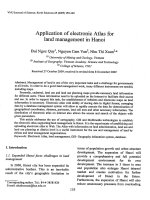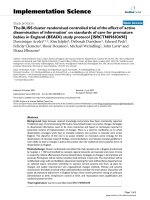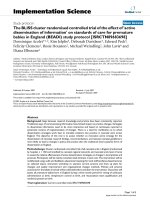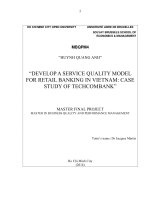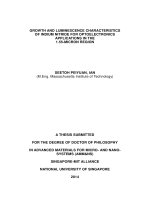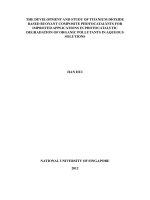The status of production and demand for organic vegetables in Hanoi
Bạn đang xem bản rút gọn của tài liệu. Xem và tải ngay bản đầy đủ của tài liệu tại đây (378.2 KB, 14 trang )
Scientific Journal No35/2019
131
THE STATUS OF PRODUCTION AND DEMAND
FOR ORGANIC VEGETABLES IN HANOI
Nguyen Thi Hoai Thuong1, Bui Thi Nuong2, Mai Huong Lam3, Bui Minh Tuyen4
1,2,3
Ha Noi University of Natural resources and Environment.
4
Ha Noi Metropolitan University
Abstract: This study aims to assess the current status of organic vegetable production
and consumption in order to propose solutions to develop organic vegetable production
in Hanoi City. The data in this study was collected through reports, related research,
focus group discussions and surveying random samples of 390 consumers in Hanoi. The
research results show that organic vegetable production was facing some difficulties such
as small, scattered farming area (only accounting for 0.41% of the total vegetable
cultivated land area), low productivity (meeting for 0.1% of the local demand), organic
vegetable’s price was significantly higher than conventional vegetables (3-4 times).
Hanoi consumers have been aware of food safety and already have demand for OV
(25.6%), however, there were still several barriers in accessing and using OV. To
sustainably develop the organic vegetable production in Hanoi, the study has proposed
some specific solutions related to the overall planning policy, management mechanisms,
and communication.
Keywords: organic vegetables; consumption, production, demand, Hanoi city.
Email:
Received 10 October 2019
Accepted for publication 20 November 2019
1. INTRODUCTION
The overuse of plant protection drugs to improve crop yields has left serious
consequences not only for the general living environment, but also for agricultural
production itself. Uncontrolled use of pesticides has been shown to increase soil erosion,
soil degradation [1], reduce biodiversity [2] and ecological imbalance [3]. At the same
time, many studies have shown a close relationship among some chemicals commonly
used in plant protection drugs (such as 2,4 D; Paraquat...) and cancer development. on
people [4], [5]. According to the Ministry of Health's 2018 statistics, the incidence of
cancer in Vietnam tends to increase at an alarming rate with more than 126,000 new cases
and about 94,000 deaths each year [6].
132
Ha Noi Metroplolitan University
In this context, a model of vegetable cultivation without using chemical fertilizers,
pesticides and transgenic seedlings, called organic vegetables (OV), is of great interest. OV
products are reported to have high nutrient content, be safe for users and minimize
environmental pollution [7], [8]. With these advantages, the OV farming model is expected
to help Vietnam's agriculture develop sustainably.
Hanoi capital is an area with a high population size, with an average income level
which is being improved, accompanied by a sense of health and environment protection
being changed positively gradually. According to a survey in 2018, nearly 90% of people
in Hanoi rated safe vegetables, including OV, which is essential in their daily meals [9]. At
the same time, Hanoi city after being expanded is considered very suitable for developing
OV production models, especially in suburban districts such as Ba Vi, Thach That, Chuong
My or Soc Son. Therefore, Hanoi is considered to be a potential consumption market of
OV, and it also has many advantages to develop this production model. However, the
current production of OV in the city still faces many difficulties. Therefore, we conduct
research “The status of production and demand for organic vegatables in Hanoi”, in order
to investigate the status of production and consumption of OV products, provide accurate
information about the output market's potential, thereby proposing solutions to develop OV
production model in Hanoi, meeting environmental and community health benefits.
2. MATERIALS AND METHODS
2.1. The method of data collection:
Secondary data: Data related to production situation such as area, OV production...
are inherited from the reports in 2018 published in the main magazines and websites of
ministries and related organizations.
Primary data: Information on distribution channels, quality inspection and monitoring
activities as well as factors affecting OV production were collected from group discussions
of OV producing households. Perceptions about OV, needs and access issues OV markets
were collected by interviewing 390 users from 18 to 60 who were randomly selected by
semi-structured questionnaires. The in-depth interview method is applied to retail store
owners and organic production team leaders in order to collect information on origin,
price, production management and consumption of OV.
2.2. Data processing methods
Descriptive statistical analysis, calculation of evaluation criteria and content analysis
to provide the current status of OV production & consumption and needs as well as
133
Scientific Journal No35/2019
identify outstanding issues and propose solutions in order to develop production and
consumption markets of OV in Hanoi.
3. RESULTS AND DISCUSSION
3.1. Assess the current status of OV production in Hanoi
Currently, organic farming systems have caused increasing attention and has become a
development trend in many countries in recent years, especially in developing countries,
while pressure on food hygiene and safety, the quality of agricultural products and the
environment are increasing, the demand for organic products is increasing. With the active
advocacy of the Vietnam Organic Agriculture Association and the government as well as
state agencies began to pay attention to promoting the development of organic agriculture.
Table 3.1: OV cultivation area in Hanoi
Number
Evaluation criteria
Area unit
Area
Proportion (%)
1
Total vegatables area
ha
12000
100
2
Safe vegatables
ha
5000
42,6
3
VietGap vegetables
ha
224
1,9
4
OV (certificated)
ha
50
0,4
(Source: Hanoi Department of Agriculture and Rural Development, 2018)
According to 2018 data of the Department of Agriculture and Rural Development,
Hanoi has a total area of 12,000 hectares of vegetables, of which 5,000 hectares are eligible
for safe vegetable production, 224 hectares of VietGAP vegetables and 50 hectares of OV
certified. From the above results, it shows that the planned area for growing vegetables in
Hanoi is relatively large but the area for safe vegetable production and especially OV is not
much, small and scattered area occupies only about 0.41% of total vegetable planning area.
This is due to many reasons in which the environmental conditions (soil, water) and inputs
(plant varieties, etc.) must meet strict OV standards, making the area of OV model not yet
met expectation.
According to statistics, the total production of vegetables in Hanoi is approximately
569.802 tons/ year; be able to meet 60% of the demand for green vegetables (in which the
output of vegetables produced by the OV production process reaches 972 tons/ year,
meeting 0.1% of the city's vegetable demand). About 40% of the vegetables supply from
other localities such as Bac Ninh, Hung Yen, Hai Duong, Hai Phong, Vinh Phuc,
especially the amount of OV provided by Luong Son, Hoa Binh cooperative.
134
Ha Noi Metroplolitan University
Table 3.2: Area and types of OV in Hanoi city
Number
Evaluation criteria
1
Thanh Xuan
Cooperative
2
Tue Vien organic
farm (Lien Viet
Company)
3
Hoa Vien Organic
Farm (Hoa Lac
Ecological
Company)
Area
Quantity
(ha)
(tons / month)
36
3
10
Types of vegetables
40-50
Mustard greens, mustard greens,
Chinese cabbage, bok choy, spinach,
sweet potato, Chinese amaranth, red
amaranth, rice amaranth, pickled
mustard greens, Japanese jute, jute,
bitter melon, cucumber, okra ,
pumpkin, zucchini, kohlrabi, gourd,
doc mung, ripe bananas, lemongrass,
guise leaves, basil, scallions,
mugwort, black beans…
10-12
Cabbage,
mustard
greens,
mushrooms, squash, spinach, purple
cress, pickled vegetables, papaya,
zucchini, luffa, shallots, mugwort…
25-30
Cruciferous
vegetables, natural
flowers, spinach, sweet potato,
amaranth, zucchini, gourd, squash,
chayote, kohlrabi, Red and sour
amaranth, cucumber, squeegee,
dandelion...
(Source: Hanoi Department of Agriculture and Rural Development, 2018)
Each month the amount of OV from OV production models to the Hanoi market
ranges from 40 to 60 tons, with about 40 types of vegetables, fruits and spices, the number
and types of substitutes supplied to the market vary depending on the time of year. Some
types of vegetables are often supplied to the market such as Brassicajuncea, Cucumber
(Chrysanthemum coronarium L), Lettuce (Lactuca sativa Var.CapittaL.), herbs
(Coriandrum sativum), Coriander (Coriandrum sativum), High-yielding green chili
(Capsicum annum L.), Amaranth (Amaranthus mangostanus), Bitter melon (Momordica
charantia)... These vegetables are mostly imported from Hanoi Agricultural University, so
they are relatively high-quanlity. In addition, a number of organic indigenous vegetables
are also being studied and tested such as spinach..., contributing to diversifying the supply
to the OV market of Hanoi. The survey results also indicate that OV products are being
favored and appreciated by consumers with positive consumption signals.
135
Scientific Journal No35/2019
Table 3.3: Comparison of organic and conventional vegetables productivity
Chỉ tiêu
Productivity (quintal / ha / crop)
The difference in yield among organic
and conventional vegetables
OV
Safe vegetables
Regular vegetables
260
300
320
-60
(Source: Results of group discussion, 2018)
According to the Hanoi Plant Protection Department, there are currently two models
involved in organic vegetable production: a model of production of a group of households
with similar interests, such as a cooperative with a 36ha certified area, besides some
businesses. also began to respond to participate in OV production such as: Viet Lien
Company has an area of OV production of 3 hectares in Long Bien district; Hoa Lac
Exploiting Potential Co., Ltd. OV production area reaches 10 hectares in Thach That
district; OV production groups in Hanoi organize production in two forms. The first is
concentrated production in groups, group members contribute land, work together,
timekeeping, and share economic profits. The second is production in a separate form, the
production plan follows the group's common plan, but the area of each household in the
group takes care of itself, harvests and consumes it in groups. Enterprises mainly operate in
the form of centralized production management, such as hiring fields and hiring employees
to organize production. Comparison of vegetable production efficiency based on organic
vegetable model are presented in the table. It can be observed that despite the high input
cost, the yield of organic vegetables is significantly lower than that of conventional and
safe vegetables. The low productivity is partly due to the limited management of weeds
and pests, especially the herb drugs being used are not really effective in preventing pests.
Discuss some factors affecting OV production activities in Hanoi, the results show that
certain initial achievements have been made, demonstrating the possibility of developing
organic agriculture in the area. However, at present, these models are still facing many
difficulties and challenges, making farmers not really want to convert to organic
agricultural production due to the attraction of low income and unsatisfactory commitment
consumption market, OV products have not been introduced to the majority of consumers.
Moreover, the production process is rigorous, it takes a long time to improve the soil and
create irrigation water to meet the quality requirements, so production and labor costs...
136
Ha Noi Metroplolitan University
Priority
Positive effect
Negative effect
1
There is support from the project on Awareness and confidence of consumers
breeding
on OV is very limited
2
Change farming practices and use of
Market and channel of consumption are
pesticides of farmers, improve the
not diverse and not guaranteed
responsibility of the people
3
Ensure health
consumers
4
Create job opportunities, improve income
for
producers
and High labor costs, low productivity and
many risks of pests and diseases
Current policies are indicative and not
specific
(Source: Results of group discussion, 2018)
3.2. Current status of consumption of OV products in Hanoi
Demand for Hanoi City for vegetables is quite large, estimated at 2,500-3,000 tons/
month. The survey results from OV producing households are mapped in Figure 3.1
showing the distribution channels and consumption of OV products to consumers in Hanoi
market. Currently OV is consumed through two main channels: direct consumption
channel and indirect consumption channel as follows.
Direct OV consumption channel: About 30% of the production OV is consumed in
this form but this consumption channel is often unstable. This type of product consumption
is mainly through contracts with safe agricultural stores, direct orders of households, local
product introduction stores or direct contracts of supermarkets, hotels and restaurants and
some retail stores of safe vegetables.
Indirect consumption channel: This is the main form of consumption (accounting for
about 70%), OV products will be supplied to consumers through consumption contracts
with organic product distribution businesses. In order to consume products through this
channel, households must commit to product quality and be subject to internal supervision
of enterprises during the production process. Businesses use their brand name and
reputation to sell products to supermarkets / restaurants / hotels or follow retail chain of
distribution of clean food. The volume and price discussed before changing, normally the
purchasing price of fruits and vegetables of all kinds is stable on average 15,000 VND/ kg,
participating in this consumption channel, on average, each household produces OV. have
an income of about 5-7 million / month after deducting expenses.
137
Scientific Journal No35/2019
intergroup
cooperative
Local market
Product introduction store
Enterprise
Consumers
Supermarket / Hotel /
Restaurant / Retail Store
Figure 3.1: OV distribution and consumption channel in Hanoi city
(Source: Results of group discussion, 2018)
For the retail distribution system in Hanoi, OV has been being displayed at 41
supermarkets, shops, agents selling OV such as: Soi Bien clean food chain, Bac Tom clean
food chain, Haprofood, Vian food 9 Food, Ecofood, Donavi, Top Green, Duyen Hai,
Clever Food chain... Not only limited to specialized high-end shops, organic products are
present in all supermarkets and hypermarkets such as Co.opmart, Co.opXtra, Big C, Lotte
Mart, Aeon, Emart, Unimart, Michimart which are close to residential areas and offices,
mostly concentrated in Thanh Xuan districts, Ha Dong, Hoan Kiem... According to OV
products trading establishments, OV's products initially meet the needs of consumers but
are limited in types and models of products. Moisture specifications products do not really
meet the requirements of consumers. Survey results from OV products shops, the average
number of customers of the store is 100-120 passengers/ day. The object of regular
customers shopping is from 35 to 50 years old. OV sales are usually highest in the summer,
as the number and model of supplies are more diverse. The survey results show that the
majority of OV products (about 80%) are sold at the chains of clean food stores,
supermarkets or stores when they reach the consumers with the cost is 3-4 times as the cost
of regular vegetables. Survey results show that the average price of 1 kg of OV sold in the
market is from VND 32,000/kg, some organic herbs cost 65,000 VND/kg. Whereas
ordinary selling price is only about VND 8,000 - 10,000/kg. On the other hand, there still
exists the fact that about 20% of OV vegetables consumed in local markets are not sold at
OV prices that may even be lower than regular vegetables. This can be explained by the
138
Ha Noi Metroplolitan University
bad design due to the invasion of pests, diverse species and consumers who do not really
know the value of OV and often equate OV and other common vegetables. This is one of
the barriers to OV model development. OV prices in the market are summarized in
Table 3.3.
Table 3.4: OV prices in the market of some OV stores
Cost (VNĐ)
Store
Leafy vegetables
(kg)
Fruit vegetable
(kg)
Root vegetables
(kg)
System of Soi Bien stores
32.000
30.000 -60.000
35.000 - 80.000
Duyen Hai store
32.000
30.000 -60.000
35.000 -80.000
32.000 -50.000
35.000 -70.000
35.000 -100.000
The system of Bac Tom stores
(VinaGap Company)
(Source: Summary of survey data, 2018)
3.3. Demand for using OV products in Hanoi city
About consumer awareness of vegetable quality in the market: Plays an important role
in the consumption of organic vegetables. When people understand the situation as well as
the nature and role of vegetables quality, they actively seek for quality and safe vegetables
and are willing to buy at a higher price than those who have less knowledge. Survey results
on consumers' perceptions of vegetable quality in the study area show that over 71% of the
respondents confirmed that regular vegetables are unsafe because they do not know the
origin as well as the production process and are known at the same time. Additional
information regarding plant protection drug abuse. However, up to 10% do not know if
vegetables are safe or not pay much attention to vegetable quality, about 15% of
consumers think that vegetable quality is quite safe. This indicates that people have begun
to recognize health risks from using unsafe vegetables on the market.
Table 3.5: Assessment of consumers on vegetable quality in Hanoi (N = 390)
Number
Evaluation criteria
Respondent
Proportion (%)
1
Absolute safe
4
1
2
Safe
69
18
3
Not safe
277
71
4
Do not know, do not care
39
10
390
100
Total
(Source: Summary of survey data, 2018)
139
Scientific Journal No35/2019
About the choice of vegetable supply channel: partly reflects the consumers' need for
safe vegetable quality. In the study area, consumers access different supply channels such
as markets, supermarkets, clean / organic food stores, in the garden. In which people
mainly come to the market to buy food including vegetables for their families because it is
easy to choose thanks to a variety of vegetables that are plentiful, convenient and
especially cheap in line with the financial spending of the majority of consumers in Hanoi.
However, there are many consumers who choose safe supermarkets or vegetable shops to
buy high-quality and safe products for their families, although the price is high and it is not
convenient to buy. A small number of consumers living in suburban areas choose to buy
vegetables at the acquaintances' garden because of the trust in quality and affordable
prices.
Table 3.6: Factors affecting the selection of vegetable supply channels of consumers (N = 390)
Number
Supply channel
The number
of people
Reason for choosing
1
Markets
200
Diversity, convenience and cheap cost
2
Supermarkets
150
Convenience, quality assurance and
safety
3
Clean vegetable/ OV stores
40
Safety
4
At the garden of acquaintances
20
Quality belief and cheap cost
(Source: Summary of survey data, 2018)
Current situation of demand for vegetables / OV: In order to assess the status of full or
partial use of OV in daily meals, the results are shown in Table 3.7.
Table 3.7: Vegetable consumption characteristics of surveyed consumers (N = 390)
Number
Features of vegetable consumption
Frequency
Proportion (%)
290
74,4
1
Consumption of regular vegetables only
2
Consumption of OV only
8
2,1
3
Most OVs, sometimes with regular and safe
vegetables
20
5,1
4
Most common vegetables and safe vegetables,
sometimes with OV
58
14,9
5
Regular vegetables, safe vegetables and OV are
equal
14
3.5
390
100
Total
(Source: Summary of survey data, 2018)
140
Ha Noi Metroplolitan University
The summary results in Table 3.4 show that most consumers in Hanoi area still use
regular vegetables (accounting for 74.4%), the number of consumers who choose to use
OV products at different levels in family meals is significant (accounting for 25.6%). This
also shows that the benefits of OV have been a significant part of consumers. However, the
percentage of consumers using OV only accounts for a modest percentage (2%), possibly
not only related to cognitive problems, but also due to income and status issues, the
availability, accessibility and reliability of OV domestically products.
About information channels of OV products: This is a very important issue, even
directly affecting the choice of consumers, because of the accuracy, completeness and
reliability of OV products. In the context that the information channels that consumers
access are quite diverse, the structure of the main types of information channels is shown
in Figure 3.2:
Figure 3.2: Channels that receive OV product information of customers in Hanoi
(Source: Summary of survey data, 2018)
The survey results show that the most popular OV information channel for consumers
is via TV (newspaper, radio) and internet. Television (newspapers, radio - accounting for
52%) is a traditional information channel with high origin and high quality because it is
censored by the authorities. Recently, food safety issues including OV are increasingly
concerned and mentioned in many categories, integrated into many news programs. It can
be seen that this information channel contributes a big part in introducing OV to
consumers. The second most popular channel is the Internet (accounting for 34%), which
is a potential information channel which is a trend in the 4.0 era. The internet channel is
accessible to young workers, although the information is multidimensional but the quality
is difficult to censor, sometimes inconsistent. This is an information channel which is
evaluated as an active way of consumers, having the opportunity to introduce OV to
consumers simply and quickly.
In addition, the information channel from product packaging is very important, due to
the factors of origin, nutritional composition, branding... and especially the licensing of the
authorities. However, at present the information on the packaging of OV products in the
141
Scientific Journal No35/2019
country is often incomplete and transparent, only recorded in a very general manner,
following the OV standards. This situation creates a matrix of OV items, inconsistencies,
causing bad consequences, making consumers not trust and decide not to use.
About the type of OV that consumers prefer: Survey results on 390 people with 04 OV groups
showed that the OV group eating leaves (cabbage, lettuce...) was used the most (202/390 people,
accounting for 51.8%), on the contrary, group of vegetables with tubers (sweet potatoes, potatoes,
carrots...) is less popular (23/390 people, accounting for
5%).
Figure 3.3: The OV category is popular with consumers
(Source: Summary of survey data, 2018)
The imbalance in the structure of the preferred OV species can be explained by the
fact that consumers believe leafy vegetables are the most heavily affected group of abuse
of plant protection drugs because of direct contact with chemicals used for spraying and
watering. Meanwhile, root vegetables do not come in direct contact, or have a thick skin
and are removed during cooking, so it is believed to be less affected by chemicals. In
addition, this issue is related to the eating habits or culture of the main consumer
department.
3.4. Factors affecting access and demand for OV products
Table 3.8: Some barriers to OV access and use in Hanoi City
Number
Evaluation criteria
Respondent
(390)
Proportion (%)
1
Do not know where OV is sold
58
9.7
2
Do not trust OV
180
30.0
3
The price of OV products are too high
290
48.3
4
Not available and less diverse in categories
30
5.0
5
Not accessible, not convenient
42
7.0
(Source: Summary of survey data, 2018)
142
Ha Noi Metroplolitan University
The results in the table show that high price is the main factor, nearly 70% of
respondents think that high price compared to income is a big barrier to the intention to
access OV products. In addition, consumers' confidence in OV products is not high due to
lack of clear information and control, monitoring and evaluation to ensure the quality of
the authorities is still loose. Many consumers assert that if quality assurance, the price of
OV is 30-40% higher than normal vegetables still acceptable. In addition, the not
diversified variety and unfavorable locations for selling vegetables are also preventing
consumers from accessing OV market.
3.5. Proposing some solutions to develop OV model in Hanoi
The results of the above assessment of OV production and consumption have shown
that the problem exists at all stages of the OV supply chain, it is necessary to have a series
of synchronous solutions, with participation and cooperation with the authorities,
production facilities and consumers, to promote the development of this model in Hanoi.
The research team would like to offer some specific solutions as follows:
- General solution of land fund: fragmented land planning and small-scale production
scale are major factors affecting the development of OV production model. The
government needs to have a comprehensive planning policy to minimize the impact of
normal vegetable production activities in the area, make the most of the area reserved for
OV development, create favorable conditions for the construction and Infrastructure
management which inherently requires very strict criteria.
- Solutions to reduce OV product cost: OV product price is a major obstacle to OV
consumption of people. In order to reduce the cost of OV products, the government needs
practical support policies and programs (such as loan support, technology transfer in
farming, etc.) to reduce costs and increase production efficiency, improve quality, help
increase competitiveness with other vegetables on the market.
- Solutions to strengthen consumers ' confidence in OV products: by strengthening
control and management of OV production and distribution; Training qualified human
resources for OV quality monitoring and supervision, strengthening OV safety and quality
control in the process of production and consumption in the market; Strengthening OV
sales network through supermarkets, OV specialty shops, distribution systems which have
partly trusted consumers' quality of products; Focus on branding by providing complete
information on labels and product packaging, with customer service promotion.
- Communication solutions: It is very important to raise consumers' awareness about
OV, so that consumers can understand correctly and fully, proceed to accept and be willing
Scientific Journal No35/2019
143
to pay for OV products. Propaganda programs need to be conducted regularly, in a variety
of forms, practical and specific. It is necessary to concentrate investment and build
propaganda programs through regular information channels.
- Solutions to build and expand OV distribution system: integrate clean food chains
into regular distribution forms to create favorable conditions for consumers to easily access
OV supply.
4. CONCLUSION
Through the study, we can draw some conclusions as follows:
- The model of organic vegetable production is proving to be a potential model with
the participation of many different subjects such as farmer groups and enterprises, which
have initially achieved certain successes, but the model are still facing many difficulties
and challenges such as small planning area, low productivity, high production costs, and
guiding policies that are not specific.
- The situation of OV consumption is quite positive with many distribution channels,
but the high price of products compared to the average income of consumers is an issue of
concern.
- People have had awareness of food safety issues and have demand for OV, but
meeting the demand depends on many factors. The study has shown many practical
solutions related to communication, planning and management to develop OV model in
Hanoi.
REFERENCES
1.
Rahman, K. and D. Zhang, Effects of fertilizer broadcasting on the excessive use of inorganic
fertilizers and environmental sustainability. Sustainability, 2018. 10(3): p.759.
2.
Kanekar, P.P., et al., Biodegradation of organophosphorus pesticides. Proceedings-Indian
National Science Academy Part B, 2004. 70(1): p.57-70.
3.
Sánchez-Bayo, F., S. Baskaran, and I.R. Kennedy, Ecological relative risk (EcoRR): another
approach for risk assessment of pesticides in agriculture. Agriculture, Ecosystems &
Environment, 2002. 91(1-3): p.37-57.
4.
Park, S.K., et al., Cancer incidence among paraquat exposed applicators in the Agricultural
Health Study: a prospective cohort study. International journal of occupational and
environmental health, 2009. 15(3): p.274-281.
5.
Bassil, K.L., et al., Cancer health effects of pesticides: systematic review. Canadian Family
Physician, 2007. 53(10): p.1704-1711.
144
Ha Noi Metroplolitan University
6.
Ministry of Health, Statistical Report. 2018.
7.
Conacher, J. and A. Conacher, Organic farming and the environment, with particular reference
to Australia: a review. Biological Agriculture & Horticulture, 1998. 16(2): p.145-171
8.
Crinnion, W.J., Organic foods contain higher levels of certain nutrients, lower levels of
pesticides, and may provide health benefits for the consumer. Alternative Medicine Review,
2010. 15(1)
ĐÁNH GIÁ HIỆN TRẠNG SẢN XUẤT VÀ NHU CẦU SỬ DỤNG
RAU HỮU CƠ TRÊN ĐỊA BÀN THÀNH PHỐ HÀ NỘI
Tóm tắt: Nghiên cứu này nhằm đánh giá thực trạng sản xuất và tiêu dùng rau hữu cơ, đề
xuất giải pháp phát triển mô hình rau hữu cơ tại thành phố Hà Nội. Các dữ liệu trong
nghiên cứu này được thu thập thông qua các báo cáo, nghiên cứu, thảoluận nhóm người
sản xuất rau hữu cơ và kết quả phỏng vấn 390 người tiêu dùngđược lựa chọn ngẫu nhiên
trên địa bàn thành phố Hà Nội. Kết quả nghiên cứu cho thấy, mô hình này đang vấp phải
một số khó khăn như diện tích quy hoạch nhỏ lẻ (chiếm 0,41% tổng diện tích đất canh
tác), năng suất thấp (đáp ứng 0,1% nhu cầu của khu vực), giá thành sản phẩm còn cao
hơn đáng kể so với rau thông thường (gấp 3-4 lần). Người tiêu dùng Hà Nội đã bước đầu
nhận thức về an toàn thực phẩm và đã có nhu cầu sử dụng RHC (25,6%), tuy nhiên, còn
nhiều rào cản trong việc tiếp cận và sử dụng RHC. Để phát triển bền vững mô hình rau
hữu cơ tại Hà Nội, nghiên cứu đã đề xuất một số giải pháp cụ thể liên quan đến chính
sách quy hoạch tổng thể, cơ chế quản lý và truyền thông.
Từ khóa: Rau hữu cơ; tiêu thụ, sản xuất, nhu cầu, thành phố Hà Nội.


